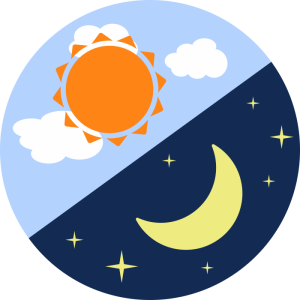This week we had a very interesting discussion with our primary school learners about the duration of a day on small planets: Mercury, Venus, Mars and…Earth. If you think you know the answers perfectly well, you might get surprised!
But before we look at all the inner planets one by one, let us ask you a question:
What would you call a day?
We asked our Y5 space dome visitors to define what a day is, and the children gave us two answers:
Some said that it is the time it takes for the planet to spin 360 degrees on the spot. (From now on we will refer to it as a sidereal day).
Others pupils came up with “a period between one sunrise and the next”. (This is what we will call a solar day).
Aren’t the two the same thing, you may ask? Let’s find out!
Earth
On Earth, that spins quickly and orbits slowly, the two are practically the same thing. It takes 23 hours 56 minutes and 4.1 seconds for the Earth to spin once on its axis. Just 4 minutes longer (i.e. 24 hours) passes in every place on the planet between one sunrise and the next. The reason why the next sunrise take an extra 4 minutes is the Earth’s orbital motion. Every day the Earth advances approximately 1 degree on its orbit (since in 365 days it completes a 360 degrees orbit). Therefore to see the next sunrise in a particular location on the Earth one has to wait for the Earth to make an extra 1 degree turn, which takes about 4 minutes!
Conclusion: on Earth a sidereal day is shorter than a solar day by approximately 4 minutes. Both periods are considerably shorter that one Earth’s year.
Mars
Mars, just like the Earth, spins fast and orbits slowly. Sidereal day and solar day (or sol) on the red planet last approximately the same time: 24 hours 37 minutes 22.7 seconds vs 24 hours 39 minutes 35.2 seconds. A year on Mars lasts almost twice as long as on Earth: 687 Earth days!
The other two inner planets, Mercury and Venus, take a comparable time to orbit and spin. And things on these planets look very different if not to say completely weird!
Mercury
Mercury is the fastest planet in the Solar System. It completes one orbit around the Sun in less than 88 days. For a long time astronomers suspected that Mercury has a synchronized rotation. Which means that its orbital and rotational periods are the same and the same side of Mercury is always facing the Sun. But observations with the Arecibo Radio Telescope showed that it’s not true. Instead, 3:2 resonance takes place. For every two orbits Mercury spins 3 times on its axis. It turned out the planet takes 58.7 Earth days to spin on its axis once (that’s sidereal day). But if you are standing on the surface of Mercury waiting for the next sunrise, be patient. There is a long wait ahead. Because the two values, sidereal day and orbital period, are quite close, Mercury will leap quite far away on its orbit while completing one turn on its axis. As a result, a day-night cycle (or solar day) on the small planet lasts 176 days.
Conclusion: a sidereal day on Mercury is shorter than Mercurian year. A solar day on Mercury is longer than Mercurian year.
Venus
The second planet from the Sun, Venus, takes 224.7 Earth days to complete one orbit. Venus is the slowest of all the Solar System planets when it comes to rotating on its axis. It takes 243 Earth days to spin around once (sidereal day). And the weirdest thing is, its rotation is retrograde, meaning the planet spins in the opposite way that it orbits the Sun (and in the opposite way from most other planets). As a result, if you live on Venus (although we would very strongly advise you against it) you will see the next sunrise before the year is out! One day-night cycle, or solar day, last around 116.75 Earth days. And, of course, the Sun rises in the West!
Conclusion: On Venus one sidereal day lasts longer than a year while one solar day is shorter than a year.
So the next time somebody asks YOU how long is a day on one of the small planets, ask them in return what “day” they mean: sidereal day or solar day! Because now you know that the two are not the same thing!
Still curious?
If you want to learn more about our Solar neighbourhood, visit one of our portable planetarium Solar System sessions. Or send your questions and comments to our inflatable planetarium team!

